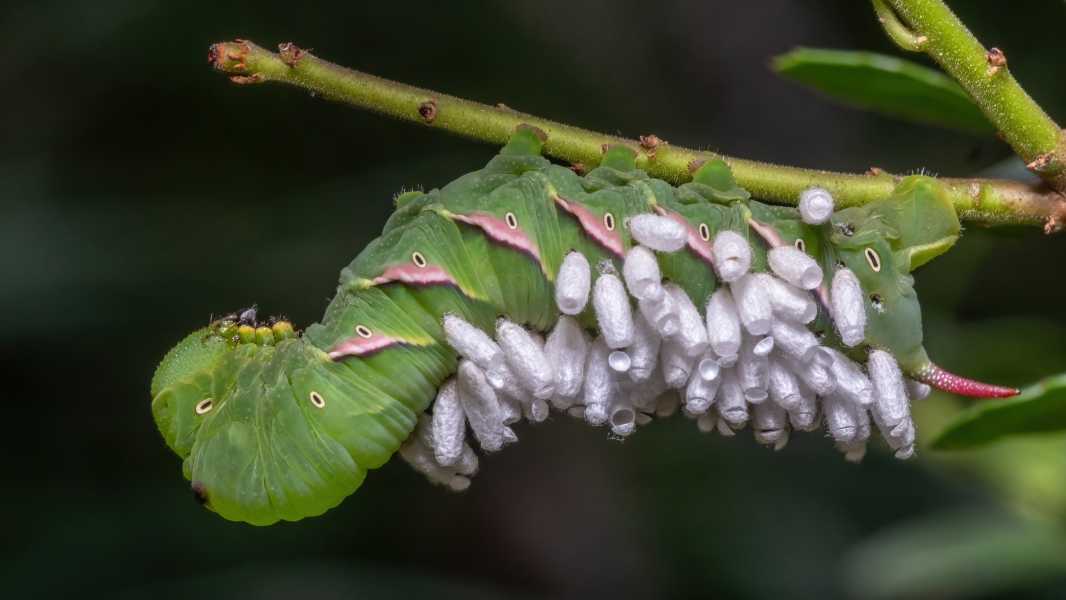
An example of creepy insect zombification occurs when parasitic wasps lay their eggs inside caterpillars. The larvae work their way through the caterpillar's body to create cocoons on its back. (Photo by Samuel Ray/Getty Images)
Right now, dozens of wasp larvae could be inside a caterpillar in your yard. By burrowing holes in its exoskeleton, these larvae form cocoons on the caterpillar's back to grow into adults, continuing to feed off their host.
This type of parasitism is more common than you might think. Some of the most terrifying forms of parasitism can turn their hosts—be it an ant, a beetle, or a caterpillar—into zombie-like puppets that do the parasite’s bidding.
In her book Rise of the Zombie Bugs (Johns Hopkins University Press, 2025), science writer, media producer, and former Live Science senior writer Mindy Weisberger reveals the sinister methods parasites use to manipulate other creatures. Through vivid descriptions of the forms this mind control can take, Weisberger demonstrates that zombies are all around us—zombie bugs, to be exact.
Live Science spoke with Weisberger to find out what damage zombifying parasites can do, how they evolved, and why they resemble zombies from pop culture.
Q: As a science writer and media producer, you could write about a variety of topics. Why did you choose to focus on parasitic mind control and zombie bugs?
Weisberger: It's just fascinating — that's the short answer! I think it has to do with how we as humans perceive autonomy and free will. The whole concept of someone who looks familiar but is influenced by an outside force that causes them to lose control of their behavior is something that is just so terrifying.
There are many examples of this kind of behavior in nature—where you have parasites that not only infect and kill their hosts, but also actively change their behavior in ways that are not at all beneficial to the host. This book was a wonderful opportunity to collect many interesting examples of behavioral manipulation, and to look at the deep history of these relationships and some of the similarities among the different groups of organisms that do it—and to see how scientists are putting these stories together and where the science is headed.
Q: Can you share the most shocking example of behavior manipulation you encountered during your research?
Weisberger: The most horrifying example, and one that I think people will see for themselves, because it’s common in backyards in temperate climates around the world, is caterpillars infested with Ichneumonid and Braconid wasps. These wasps lay their eggs inside caterpillars — and a single caterpillar can be targeted by several wasps, allowing dozens of larvae to develop inside. The larvae grow, and when they’re ready to pupate, they force their way through the caterpillar’s skin and create their cocoons on its back.
Charles Darwin was so shocked that he wrote to a biologist friend that it made him doubt the existence of a benevolent God. If it’s a connection that could shock Darwin, that certainly makes it significant. These caterpillars are quite common in gardens, so it shows that you’re probably a lot closer to a zombie than you think.
Caterpillar Infected With Mind Controlling Wasp Larvae – YouTube
See more
Q: Do you have a favorite zombie parasite, and if so, could you describe its relationship with its host?
There is another species of wasp, the jewel wasp (Ampulex compressa), which infests and manipulates cockroaches. It has a more direct approach: it stings cockroaches directly in the brain, targeting a very specific area associated with movement.
Sourse: www.livescience.com





